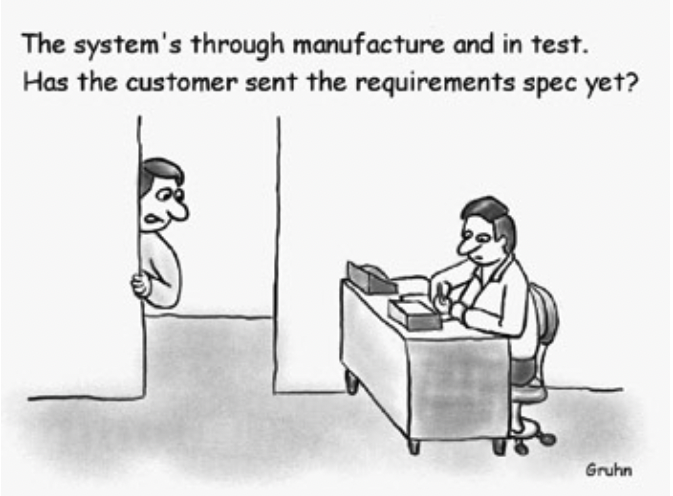home | syllabus | groups | moodle | video | review | © 2022
"Without requirements or design, programming is the art of adding bugs to an empty text file."
-- Louis Srygley
V-diagram: i.e. before you code, generate artifacts that can test that code (e.g. expectations, constraints, test cases)
- Brooks, Mythical Man Month. Effort is
- 1/3 th planning
- 1/6 th coding
- 1/4 th unit testing
- 1/4 th systems testing
e.g. test-driven development: Tests suites that run every time you save code
- Build tests first
- Repeat:
- Red = fund a broken test
- Green = fix the test
- Refactor = sometimes, clean things up
- Refactoring means functionality stays the same but the resulting code is better.
- Aside, regarding refactoring, apply the rule of 3. When you find repeated hunks of code:
- first time you do it here, just do it
- second time you do it there , note that you did this before
- third time, before you do it somewhere else, yet again:
- don't do it again.
- Instead, refactor so here, there and somewhere else are all handled by the one piece of (refactored) code
- "The development and use of cost- effective technology for the elicitation, specification and analysis of the stakeholder requirements which are to be met by software intensive systems.”
- Beware analysis paralysis
- "The systems's through manufacture and in test. Has the customer sent the requirements spec yet"
- Fans of agile say
- "Experience tells you more than excessive initial analysis"
- Assessing any of the following in a rigorous manner is an open research issue
- Completeness
- Comprehensibility
- Testability
- Consistency
- Unambiguity
- Writeability
- Modifiability
- Implementability
- As to the real value of requirements....
- Ideally, we look before we leap • Find best ways to do proceed
- And we don’t get it wrong
- In reality, our initial peeks are wrong
- Need extensive modification
- If you want God to laugh, tell her your plans
- Recent research says requirements are an illusion
- Cognitive phenomena including anchoring bias, fixation and confirmation bias
- Misrepresenting decisions as requirements in situations where no real requirements are evident.
- Misrepresenting an incidental feature as a requirement will reduce exploration of the design space, curtailing innovation
- Ideally, we look before we leap • Find best ways to do proceed
- Nevertheless, sometime in your career,
- you will be asked “how do we start?”
- you will be asked (by an accountant) "has IT been delivered?" and they will want a precise definition of "IT"
- Welcome to the black art of requirements engineering
Examples to make you tremble
Must have mobility access ramps
Must have external staircase
The Geneis crash landing
- NASA deep space sample return probe
- collected a sample of solar wind
- returned it to Earth for analysis
- Then crash landed in Utah in 2004
- Landing chute did not deploy
- Design error
- Acceleration installed backwards
- Cost
- $164 million for spacecraft development and science instruments
- $45 million for operations and science data analysis.
- Mistake have been made worse by reuse
- Same design in the (already launched) Stardust cometary sample return craft
- Stardust landed successfully in 2006.
| What | What | Sadness | Observed | Cause |
|---|---|---|---|---|
| HMS Sheffield Exocet Missile Mis- classification | May 4, 1982 | 30 deaths 257 lives at risk £23,200,000 | Failure to intercept incoming missile. Ship loss | inadequate requirements; unnecessary simplicity |
| Y2K (*) | Jan 1, 2000 | $100 Billion (usa) | large-scale effort ;widespread problems | Short-sighted temporal requirements. Premature optimization. Arithmetic overflow |
| Virtual Case File | 2000- 2005 | $170,000,000 | entire program scrapped | •shifting requirements •scope creep •mismanagement |
| Vancouver Stock Exchange Rounding Error | 1984 | unspecified , index off by 50%(!) | •inadequate research •inadequate testing •rounding error | |
| NASA Mariner 1 | 1962 | A booster went off course during launch, resulting in the destruction | • Failure of a transcriber to notice an overbar in a written specification for the guidance program, resulting in the coding of an incorrect formula in its FORTRAN software |
(*) (*) A similar problem will occur in 2038 (the year 2038 problem), as many Unix-like systems calculate the time in seconds since 1 January 1970, and store this number as a 32-bit signed integer, for which the maximum possible value is 231 − 1 (2,147,483,647) seconds.[19]
Jim Johnson, The Standish Group International Project Leadership Conference, Chicago:
| What | Pecent% |
|---|---|
| 1. Incomplete Requirements | 13.1 |
| 2. Lack of user involvement | 12.4 |
| 3. Lack of resources | 10.6 |
| 4. Unrealistic Expectations | 9.9 |
| 5. Lack of executive support | 9.3 |
| 6. Changing requirements | 8.7 |
| 7. Lack of planning | 8.1 |
| 8. Didn’t need it any longer | 7.5 |
| 9. Lack of IT management | 6.2 |
| 10. Technology illiteracy | 4.3 |
Do all these folks want the same thing?
“one” thing is “many” things, depending on stakeholder perspective.
Do all these folks want the same thing?
Stakeholders have different “non-functional requirements”

- properties, or qualities, that the product must have • may be critical to the product’s success
| Quality attribute | Key interest |
|---|---|
| Availability | Can I use the system when and where I need to? |
| Conformance to standards | Does the system comply with all applicable standards for functionality, safety, communication, certification, and interfaces? |
| Efficiency | Does the system use computer resources economically? |
| Installability | Can I easily install, uninstall, and reinstall the system and upgrades? |
| Integrity | Does the system protect against data inaccuracy, corruption, and loss? |
| Interoperability | Does the system connect well with others to exchange data and services? |
| Maintainability | Can developers easily modify, correct, and enhance the system? |
| Performance | Does the system respond sufficiently quickly to user actions and external events? |
| Portability | Can the system be migrated to different platforms easily? |
| Reliability | Does the system run when it’s supposed to without failing? |
| Reusability | Can developers reuse portions of the system in other products? |
| Robustness | Does the system respond sensibly to erroneous inputs and unexpected operating conditions? |
| Safety | Does the system protect users from harm and property from damage? |
| Scalability | Can the system easily expand to accommodate more users, data, or transactions? |
| Security | Does the system protect against malware attacks, intruders, unauthorized users, and data theft? |
| Usability | Can users easily learn how to use the system to accomplish their tasks? |
| Verifiability | Can testers determine whether the software was implemented correctly? |
- Time
- Transactions / sec
- Response time
- Time to complete an operation
- Space
- Main memory
- Auxiliary memory - (Cache)
- Usability
- Training time
- Number of choices - Mouse clicks
- Reliability
- Mean time to failure - Downtime probability - Failure rate
- Availability
- Robustness
- Time to recovery
- % of incidents leading to catastrophic failures
- Odds data corruption after failure
- Portability
- % of non-portable code
- RunsonNoperatingsystems - Runs on desktop, tablet, mobile
- Etc
Column effects row
- optimizing for effeciency (col2) hurts lots of things (row3 to row8)
- reliabillity (col8) helps avialbility (row1)
- availability (col1) helps maintainability (row6) and reliability (row8)
- but maintainability (col6) says nothing about a availabilty (row1)
- maintainability hurts portability (in this project)
- but portability does nothing to maintainability (no, I don't know why either)
(Note that the rules are only approximate and may not hold for specific projects.)
How to "test" something that does not yet execute (pic)
- separate:
- xfr (nonfunctionals)
- stories (definition of user-level demos)
- actual system requirements
- things talked about but might do best in future systems.
One thing to look for: is there more than one design? Have those options been assessed? (pic)
Assessing options of criteria (pic)
- predictability (1), security (2), adaptability (3), coordinability (4), cooperativity (5), availability (6), integrity (7), modularity (8), or aggregability (9)
- Which is best? Dunno. Ask your stakeholders!
- But add value to their discussions
- Give them considered conclusions to aid their decisions
- Validity
- Does the system provide the functions which best support the customer’s needs?
- Consistency
- Are there any requirements conflicts?
- Completeness
- Are all functions required by the customer included?
- Realism
- Can the requirements be implemented given available budget and technology
- Verifiability
- Is the requirement realistically testable?
- Comprehensibility
- Is the requirement properly understood?
- Traceability
- Is the origin of the requirement clearly stated?
- Adaptability
- Can the requirement be changed without a large impact on other requirements?
- The official statement of what is required of the system developers
- Should include both a definition and a specification of requirements
- It is NOT a design document
- As far as possible, it should set of WHAT the system should do rather than HOW it should do it
- Also, it should have tests that can be applied incrementally
- See “commit partition”, below
-
Introduction
- Describe need for the system and how it fits with business objectives
-
Glossary
- Define technical terms used
-
System models
- Define models showing system components and relationships
-
Functional requirements definition
- Describe the services to be provided
- User stories go here
- Add in notes for the commit partition here
-
Non-functional requirements definition
- Define constraints on the system and the development process • Add in notes for the commit partition here
-
Constraints
- What can't happen
- What has to happen
-
System evolution
-
Define fundamental assumptions on which the system is based and anticipated changes
-
Requirements specification
- Detailed specification of functional requirements
-
Appendices
- System hardware platform description
- Database requirements (as an ER model perhaps)
-
Index















